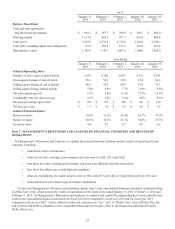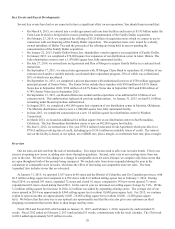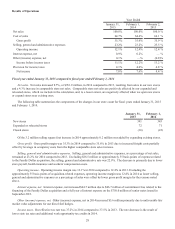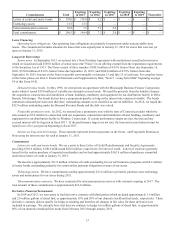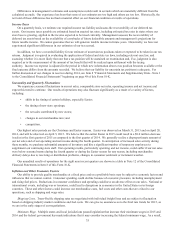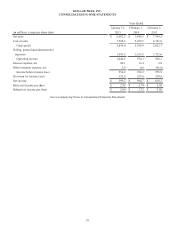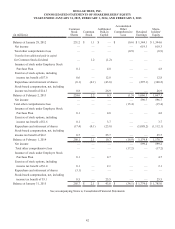Dollar Tree 2014 Annual Report Download - page 51
Download and view the complete annual report
Please find page 51 of the 2014 Dollar Tree annual report below. You can navigate through the pages in the report by either clicking on the pages listed below, or by using the keyword search tool below to find specific information within the annual report.35
Differences in management's estimates and assumptions could result in accruals which are materially different from the
calculated accruals. Our experience has been that some of our estimates are too high and others are too low. Historically, the
net total of these differences has not had a material effect on our financial condition or results of operations.
Income Taxes
On a quarterly basis, we estimate our required income tax liability and assess the recoverability of our deferred tax
assets. Our income taxes payable are estimated based on enacted tax rates, including estimated tax rates in states where our
store base is growing, applied to the income expected to be taxed currently. Management assesses the recoverability of
deferred tax assets based on the availability of carrybacks of future deductible amounts and management’s projections for
future taxable income. We cannot guarantee that we will generate taxable income in future years. Historically, we have not
experienced significant differences in our estimates of our tax accrual.
In addition, we have a recorded liability for our estimate of uncertain tax positions taken or expected to be taken in our tax
returns. Judgment is required in evaluating the application of federal and state tax laws, including relevant case law, and
assessing whether it is more likely than not that a tax position will be sustained on examination and, if so, judgment is also
required as to the measurement of the amount of tax benefit that will be realized upon settlement with the taxing
authority. Income tax expense is adjusted in the period in which new information about a tax position becomes available or the
final outcome differs from the amounts recorded. We believe that our liability for uncertain tax positions is adequate. For
further discussion of our changes in reserves during 2014, see Item 8 “Financial Statements and Supplementary Data - Note 3
to the Consolidated Financial Statements” beginning on page 48 of this Form 10-K.
Seasonality and Quarterly Fluctuations
We experience seasonal fluctuations in our net sales, comparable store net sales, operating income and net income and
expect this trend to continue. Our results of operations may also fluctuate significantly as a result of a variety of factors,
including:
• shifts in the timing of certain holidays, especially Easter;
• the timing of new store openings;
• the net sales contributed by new stores;
• changes in our merchandise mix; and
• competition.
Our highest sales periods are the Christmas and Easter seasons. Easter was observed on March 31, 2013 and on April 20,
2014, and will be observed on April 5, 2015. We believe that the earlier Easter in 2015 could result in a $8.0 million decrease
in sales in the first quarter of 2015 as compared to the first quarter of 2014. We generally realize a disproportionate amount of
our net sales and of our operating and net income during the fourth quarter. In anticipation of increased sales activity during
these months, we purchase substantial amounts of inventory and hire a significant number of temporary employees to
supplement our continuing store staff. Our operating results, particularly operating and net income, could suffer if our net sales
were below seasonal norms during the fourth quarter or during the Easter season for any reason, including merchandise
delivery delays due to receiving or distribution problems, changes in consumer sentiment or inclement weather.
Our unaudited results of operations for the eight most recent quarters are shown in a table in Note 12 of the Consolidated
Financial Statements in Item 8 of this Form 10-K.
Inflation and Other Economic Factors
Our ability to provide quality merchandise at a fixed price and on a profitable basis may be subject to economic factors and
influences that we cannot control. Consumer spending could decline because of economic pressures, including unemployment
and rising fuel prices. Reductions in consumer confidence and spending could have an adverse effect on our sales. National or
international events, including war or terrorism, could lead to disruptions in economies in the United States or in foreign
countries. These and other factors could increase our merchandise costs, fuel costs and other costs that are critical to our
operations, such as shipping and wage rates.
Shipping Costs. Trans-Pacific shipping rates are negotiated with individual freight lines and are subject to fluctuation
based on shipping industry market conditions and fuel costs. We can give no assurances as to the final rate trends for 2015, as
we are in the early stages of our negotiations.
Minimum Wage. Multiple states and local jurisdictions passed legislation that increase their minimum wages in 2015 and
2016 and the federal government has made indications that it may consider increasing the federal minimum wage. As a result,


